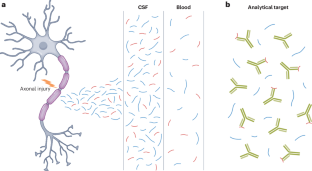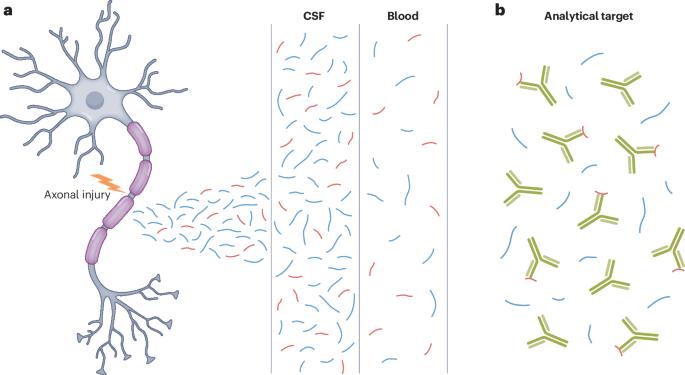作为神经系统疾病生物标记物的神经丝--走向临床应用
IF 33.1
1区 医学
Q1 CLINICAL NEUROLOGY
引用次数: 0
摘要
神经丝蛋白已被证实是神经轴突损伤的特异性体液生物标记物。高灵敏度分析平台的出现实现了对血液样本中神经丝蛋白的可靠定量,并简化了纵向跟踪,这为神经丝蛋白在临床实践中作为生物标记物的发展铺平了道路。其潜在应用包括评估疾病活动、监测治疗反应、确定许多急性和慢性神经系统疾病的预后,以及将其作为新型疗法试验的结果测量指标。目前,神经丝蛋白的测量已经进入了常规临床实践的阶段,可用于对个体进行评估。在本综述中,我们首先概述了目前有关神经丝结构和功能的知识。然后,我们讨论了在不同临床环境中确定神经丝水平的分析和统计方法及挑战,并评估了神经丝轻链(NfL)水平对正常老龄化的影响以及在解释 NfL 测量时需要考虑的混杂因素。此外,我们还总结了神经丝作为神经轴突损伤生物标记物在一系列神经系统疾病中的当前价值和潜在临床应用,这些疾病包括多发性硬化症、阿尔茨海默病、额颞叶痴呆症、肌萎缩性脊髓侧索硬化症、中风和脑血管疾病、脑外伤和帕金森病。我们还考虑了将神经丝从实验室转化为临床神经疾病治疗所需的步骤。本文章由计算机程序翻译,如有差异,请以英文原文为准。


Neurofilaments as biomarkers in neurological disorders — towards clinical application
Neurofilament proteins have been validated as specific body fluid biomarkers of neuro-axonal injury. The advent of highly sensitive analytical platforms that enable reliable quantification of neurofilaments in blood samples and simplify longitudinal follow-up has paved the way for the development of neurofilaments as a biomarker in clinical practice. Potential applications include assessment of disease activity, monitoring of treatment responses, and determining prognosis in many acute and chronic neurological disorders as well as their use as an outcome measure in trials of novel therapies. Progress has now moved the measurement of neurofilaments to the doorstep of routine clinical practice for the evaluation of individuals. In this Review, we first outline current knowledge on the structure and function of neurofilaments. We then discuss analytical and statistical approaches and challenges in determining neurofilament levels in different clinical contexts and assess the implications of neurofilament light chain (NfL) levels in normal ageing and the confounding factors that need to be considered when interpreting NfL measures. In addition, we summarize the current value and potential clinical applications of neurofilaments as a biomarker of neuro-axonal damage in a range of neurological disorders, including multiple sclerosis, Alzheimer disease, frontotemporal dementia, amyotrophic lateral sclerosis, stroke and cerebrovascular disease, traumatic brain injury, and Parkinson disease. We also consider the steps needed to complete the translation of neurofilaments from the laboratory to the management of neurological diseases in clinical practice. Neurofilaments have been validated as specific body fluid biomarkers of neuro-axonal injury. In this Review, Khalil and colleagues provide an update on the structure and function of neurofilaments, analytical approaches and challenges in different clinical contexts, and progress towards clinical application of neurofilaments as a biomarker in various neurological disorders.
求助全文
通过发布文献求助,成功后即可免费获取论文全文。
去求助
来源期刊

Nature Reviews Neurology
医学-临床神经学
CiteScore
29.90
自引率
0.80%
发文量
138
审稿时长
6-12 weeks
期刊介绍:
Nature Reviews Neurology aims to be the premier source of reviews and commentaries for the scientific and clinical communities we serve. We want to provide an unparalleled service to authors, referees, and readers, and we work hard to maximize the usefulness and impact of each article. The journal publishes Research Highlights, Comments, News & Views, Reviews, Consensus Statements, and Perspectives relevant to researchers and clinicians working in the field of neurology. Our broad scope ensures that the work we publish reaches the widest possible audience. Our articles are authoritative, accessible, and enhanced with clearly understandable figures, tables, and other display items. This page gives more detail about the aims and scope of the journal.
 求助内容:
求助内容: 应助结果提醒方式:
应助结果提醒方式:


